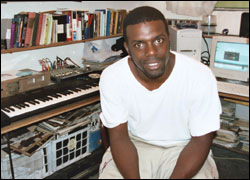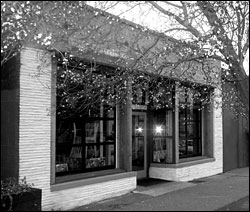Right now in Cuba it’s 1981 in terms of hip-hop. They’re just getting started. They don’t even have turntables in Cuba, but they have hip-hop.
The Roots’ Amhir “?uestlove” Thompson, The Believer, August 2003
HAVANA’S CLUB ATELIER is usually a reggae and salsa spot, but this August night is different. It’s 11 p.m. the air conditioner is broken, and at least 150 young Cubans are packed into the smoky, windowless basement. It’s hot in here, but there’s no Nelly in earshot. Politically charged Brooklynites Dead Prez weave hypnotically out of ragged speakers, and the crowddecked out in FUBU, Ecko-, and Kangoldrinks Cristal. Not the champagne favored by blinged-out rappersthe national beer, which resembles watered-down Heineken. Living on $15 a month and maybe hustling for supplementary cash, you drink what you can afford. Papo Record, a rapper-producer highly regarded in the Cuban underground, is in the club tonight, scouting talent, while a group of raperos lingers near the John Lennon statue outside, relaxing with a pre-show blunt. The night’s first group, Sindikto, bursts onto the stage, lead rapper Nativo’s youthful rhymes cutting playfully through Papa Flow’s low growl; the whole room stands up, fists in the air, with such emotion and vigor that Fidel himself might as well be spitting rhymes (He rapped onstage with premier Cuban group Doble Filo at the 1999 national baseball championship). By the time third Sindikto member Maligno takes the stage, the group is barely visible over the bouncing, fist-pumping mob.
Welcome to hip-hop a lo cubano.
Hip-hop first impacted Cuba when rooftop-rigged antennae picked up the Sugarhill Gang’s “Rapper’s Delight” and other early U.S. hits from Miami radio stations in the early 1980s. But the production of hip-hop there is a relatively recent development: Between 1989 and 1991, young Cuban producers began emulating N.W.A.’s Straight Outta Compton and Public Enemy’s Fear of a Black Planet. “By 1995, there was enough hip-hop to throw a festival,” says top Cuban hip-hop producer Pablo Herrera.
That year, poet Rodolfo Rensoli organized the first Cuban Rap Festival on the streets of Alamar, an East Havana housing project and the recognized birthplace of Cuban rap. The early festivals were crude, with rappers performing over simplistic, canned beats on rudimentary sound systems without turntables and selling rough, homemade cassettes of their material. But for a youth subculture in a Cuba still suffering the Special Periodthe economically grueling time after the 1991 collapse of the Soviet Union, a major former Cuban ally and trade partner, and before increased tourism and access to other foreign markets began to ease economic pressure in the late ’90sa festival providing an outlet for expression was invigorating and culturally important. No one has to eat cat anymore in Cuba, but despite its relative economic upswing, there are new waves of social and economic problems spurred by increased tourism. The rise of hip-hop in the country over the past decade reflects this. Herrera estimates that there are currently around 800 rap groups in Cuba, and the hip-hop festisval has been held every August for nine consecutive yearsfirst solely amongst Alamar’s seaside grid of dilapidated high-rise apartment buildings, then spreading to venues in other parts of Havana. These days, the festival gets a boost from a sponsor, the infant Cuban Rap Agency, an unprecedented government bureau formed less than a year ago, marking hip-hop’s acceptance as a part of Cuban national culture.
The festival has come a long way since its boom-box-on-the-street-corner days. Most modern audio equipment is still rare, but it’s getting easier to access, with decent sound systems, recording software, and CD burners all helping make the festival something more overtly professional. This year’s program, held Aug. 11-17, featured panels (“Feminist Social Activism as an Alternative Movement in U.S. Hip-Hop,” “Cuban Rap: Redefining Afrocubana”), daily movie screenings (8 Mile, 1984’s Beat Street, the 1964 Cuban documentary We Are the Music), and concerts by 70 groups from Cuba and elsewhere with nine all-female Cuban groups closing the festival. (An American hip-hop presence was prevented by the New York City blackout.)
Despite government attention, hip-hop remains just outside the Cuban mainstream; outside festival week, it’s a smaller, quieter scene. In the dominating presence of Cuba’s more traditional musical styles, you have to seek it out. Salsa is still the pulse of generations, but if the embargo can keep soap and toothpaste out of Cuba, it can’t stop Beyonc鮠The island’s mainstream pop is often exactly the same as that of the U.S.: This past July, I heard Nelly and Kelly’s “Dilemma” more frequently than at home. “Here, we listen to music with our bodies,” said a Cuban friend. “If we can dance to it, it’s good.”
That’s one reason hip-hop has prospered in Cuba. For a decade, young Cubans tried dancing to the music, emulating the break-dancing they glimpsed on television before picking up microphones. By the early ’90s, young black Cubans began to find hip-hopan often inherently political style with a built-in connection to a community of discontented youth around the worldmore relevant than the salsa their parents listened to.
“A generation of people born after the revolution are expressing themselves through art, expressing their African identity through culturedoing a lot of things that hip-hop initially started out doing here in the United States,” says Monifa Bandele, coordinator of Black August Hip-Hop Collective, a Brooklyn-based advocacy group that sends U.S. hip-hop artists to Cuba to perform. But while young Cubans embraced hip-hop, older generations didn’t: Early rap shows were frequently shut down. It wasn’t until fall 2002 that the government finally created its rap agency in response to artist requests, facilitating mucho hookups for artists and their fansaccess to EGREM, the state-owned recording studio; state sponsorship for the hip-hop festival and the production of a national hip-hop magazine, Movimiento; and state-sanctioned shows in some of Havana’s premier venues.
This is a remarkable achievement for a musical style whose practitioners were creating rhythm loops with double-deck cassette players five years ago. It has also required some artistic compromiseoften, obedient rappers get the goods, while artists seen as counterrevolutionary can be shut out. (This isn’t necessarily the normrappers tend to wax philosophical and political in this highly educated societybut are often quick to defend their patriahomelandwhen it counts.) As Herrera explains, “We can’t afford to be rebellious [for the sake of being rebellious],” not only because it’s unacceptable to the Cuban powers that be, but also because people in the U.S. could take those words and use them against Cuba in an unforeseen context. “It’s about knowing exactly how to say what you have to say and make sure that your commentary gets across and makes change, not just a reaction.” Herrera, who has taught courses on jazz and hip-hop at the University of Havana, notes that Cuban hip-hoppers have had to recognize that the worldview of Cuban hip-hop is different from the movement’s self-identity. “We are already hip-hop,” Herrera says. “Because of the essence and nature [of hip-hop], we will always look back to the source and emulate [U.S. rap]; the same thing happened with jazz music.”
Yet Cuban artists are now rapping about their unique reality, issues like the island’s complex racial identity structure, particularly the experience of being not white or black but mulatto, and the sex tourism many Cuban women and men resort to in order to bolster their living. There’s an analogue between the thug- and playa-life lyrics of American rappers, but songs like this year’s “La Llaman Puta” (“They Call Her Whore”), a dismal, angry treatise on prostitution by agency-sponsored female-male duo Obsesion, tend to glamorize their turf far less than Jay-Z or Clipse do.
As in the U.S., there’s a division in Cuba between mainstream rap and a larger group of underground rappers who think the mainstream is too compromised and user-friendly. Some in the Cuban underground think the Cuban Rap Agency is wack, toothat Herrera and the 10 groups in the agency are members of an elitist club that only friends can join.
Cuban rap is also unique for its musicianship. Credit for this goes in part to Cuba’s still-vital musical traditions, which several groups have taken in a rap-oriented direction. Artists like La Fabri K., a collaborative project by members of Obsesion and agency-sponsored Doble Filo, layer traditional percussion, guitar, violin, cello, sax, and even piano under their rhymes. Cuban raperos are playing a different game than U.S. hip-hop, where live musicianship has never been much of a factor (the Roots are a notable exception), and where the music has long dominated the mainstream. But its growing popularity puts the Cuban hip-hop scene at a crossroads. The music is too good to be ignored; eventually, one of the groups (perhaps popular agency-sponsored groups such as Obsesion or male duo An�o Consejo) will be signed by a major label. But with the ongoing U.S. trade embargo against Cuba, there’s little chance of America getting in on the actionfor now, at least. (Despite growing American public support to drop the ridiculous, archaic travel and trade restrictionsincluding last week’s Senate vote to scrap the travel banBush has made it clear that U.S. policies aren’t budging as long as he’s in office and Castro’s in power.)
“Will we compromise [what] we have been since the beginning in order to sell records?” Pablo Herrera asks, somewhat rhetorically. Considering pop music’s “Latin explosion” in recent years, perhaps not. If rock en espa�bands like Mexico City’s Caf頔acuba can gain a midlevel audience in the States, so, perhaps, can raperos cubanos. Some Cuban groups, like commercially minded reget�I> (Latin reggae hybrid) group Cubanito, might go even furthertheir lyrics deal with partying, not politics. But a group like An�o Consejo, one of the most revered Cuban acts, might have a tougher time breaking through. Inspired by groups like Dead Prez and Public Enemy, An�o Consejo’s lyrics are highly political, usually detailing the realities of being young, black, and Cuban; they’ve received flak from the state over the song “Las Apariencos Enqa�(“Appearances Deceive”), about racial profiling. (In 2000, member Maigel Entenza Jaramillo was reportedly detained overnight the day after the duo performed that song.) When An�o Consejo rap, Cubans listen. But worldwide, thoughtful, political rap is powerful but not necessarily profitable. There is one precedent. In 1999, premier Cuban group Amenaza was wooed by EMI France into a record deal that would lead to their dissolution. Two of the members re-formed as the Orishas and released two albums2000’s A Lo Cubano and 2002’s Emigrantebut since their modest international success, they’ve been virtually alienated from the Cuban hip-hop community, only occasionally returning to the island.
Things change, though. And despite U.S./Cuban political strain, it’s impossible to enforce a cultural blockade. Dozens of U.S. rappers, producers, scholars, and hip-hop fans have attended Havana’s hip-hop festival and other Cuban rap events in recent yearsboth independently and through Black Augustincluding Black Star, Common, Dead Prez (who were reportedly fined $2,000 by the U.S. government for visiting Cuba in violation of the travel ban), and the Roots. Tony Touch collaborated with An�o Consejo for some tracks on their latest demo, Guapo Como Mandela. And Fab 5 Freddy, the former host of Yo! MTV Raps, organized a U.S. equipment drive in New York to raise donated turntables and speakers for shipment to Cuba. New York’s International Hip-Hop Exchange brought An�o Consejo, Obsesion, and Doble Filo to New York this past June, where they performed at the Apollo with the Roots and Common.
While the embargo ensures that Cuban-produced albums are not sold in the U.S., there is one collection from New York’s Papaya Records, Cuban Hip-Hop All Stars, Vol. 1, available in most stores. With tracks by Obsesion, An�o Consejo, and other top Cuban groupsand contrabass work by famed Cuban jazz bassist Jorge Reyesthe 2001 Herrera-produced compilation is a nice, if too short and already outdated, sampling of the genre. Should the right gates open (or the right person leave the office he was never elected to in the first place), Cuban hip-hop could be gloriously more accessible in the future. They’re ready for us; the only question is whether we’ll be ready for them.







